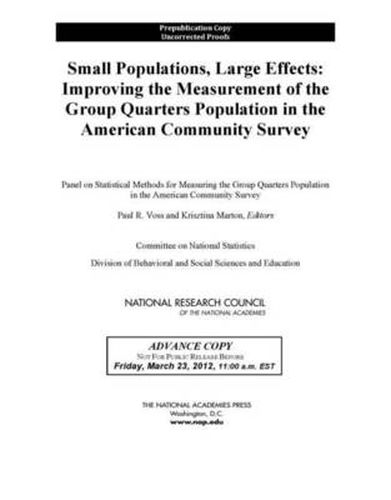Readings Newsletter
Become a Readings Member to make your shopping experience even easier.
Sign in or sign up for free!
You’re not far away from qualifying for FREE standard shipping within Australia
You’ve qualified for FREE standard shipping within Australia
The cart is loading…






In the early 1990s, the Census Bureau proposed a program of continuous measurement as a possible alternative to the gathering of detailed social, economic, and housing data from a sample of the U.S. population as part of the decennial census. The American Community Survey (ACS) became a reality in 2005, and has included group quarters (GQ)-such places as correctional facilities for adults, student housing, nursing facilities, inpatient hospice facilities, and military barracks-since 2006, primarily to more closely replicate the design and data products of the census long-form sample. The decision to include group quarters in the ACS enables the Census Bureau to provide a comprehensive benchmark of the total U.S. population (not just those living in households). However, the fact that the ACS must rely on a sample of what is a small and very diverse population, combined with limited funding available for survey operations, makes the ACS GQ sampling, data collection, weighting, and estimation procedures more complex and the estimates more susceptible to problems stemming from these limitations. The concerns are magnified in small areas, particularly in terms of detrimental effects on the total population estimates produced for small areas. Small Populations, Large Effects provides an in-depth review of the statistical methodology for measuring the GQ population in the ACS. This report addresses difficulties associated with measuring the GQ population and the rationale for including GQs in the ACS. Considering user needs for ACS data and of operational feasibility and compatibility with the treatment of the household population in the ACS, the report recommends alternatives to the survey design and other methodological features that can make the ACS more useful for users of small-area data.
$9.00 standard shipping within Australia
FREE standard shipping within Australia for orders over $100.00
Express & International shipping calculated at checkout
In the early 1990s, the Census Bureau proposed a program of continuous measurement as a possible alternative to the gathering of detailed social, economic, and housing data from a sample of the U.S. population as part of the decennial census. The American Community Survey (ACS) became a reality in 2005, and has included group quarters (GQ)-such places as correctional facilities for adults, student housing, nursing facilities, inpatient hospice facilities, and military barracks-since 2006, primarily to more closely replicate the design and data products of the census long-form sample. The decision to include group quarters in the ACS enables the Census Bureau to provide a comprehensive benchmark of the total U.S. population (not just those living in households). However, the fact that the ACS must rely on a sample of what is a small and very diverse population, combined with limited funding available for survey operations, makes the ACS GQ sampling, data collection, weighting, and estimation procedures more complex and the estimates more susceptible to problems stemming from these limitations. The concerns are magnified in small areas, particularly in terms of detrimental effects on the total population estimates produced for small areas. Small Populations, Large Effects provides an in-depth review of the statistical methodology for measuring the GQ population in the ACS. This report addresses difficulties associated with measuring the GQ population and the rationale for including GQs in the ACS. Considering user needs for ACS data and of operational feasibility and compatibility with the treatment of the household population in the ACS, the report recommends alternatives to the survey design and other methodological features that can make the ACS more useful for users of small-area data.